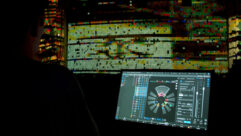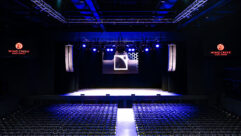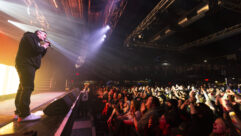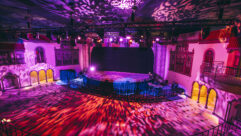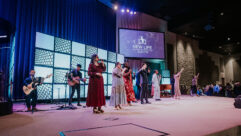
L-Acoustics dV-DOSC Brings New Life To LDS Conference Center
May 24, 2007 12:00 AM

Capable of seating an audience of more than 21,000, all of whom have an unobstructed view of the pulpit, Salt Lake City’s LDS Conference Center is a breathtaking achievement in architectural and acoustical design. Thanks to a recent installation of an L-Acoustics dV-DOSC loudspeaker system, the auditorium’s sound reinforcement system is now finally every bit on par with the room’s grandeur.
First opened by the Church of Jesus Christ of Latter-day Saints (LDS) in the spring of 2000, the 1.4 million-square-foot conference center is home to the semi-annual LDS General Conference, which packs in a full house and is broadcast worldwide to 12 million people. Furthermore, each Sunday the center hosts a performance by the world-famous Mormon Tabernacle Choir—a weekly rite that, now in its 77th year, ranks as the longest-running network broadcast in world (albeit initially only on radio).
The Center is also available as a rental venue for high-quality concerts, ceremonies, and meetings. According to LDS Sound Engineer Trent Walker, “We get quite the gamut of performers who come through this room. In addition to LDS events, there are approximately 25 other shows per year, including the National Rotary and World Barbershop conventions, concerts such as a recent performance by The Oak Ridge Boys with the Mormon Tabernacle Choir to benefit Feed the Children, and a variety of guest soloists who perform with the choir every week.”
With such prestigious events being held on a regular basis, it is crucial that not only are the choir and orchestra heard in a high enough fidelity that is worthy of the musicianship, but also that the spoken word be heard clearly and evenly at every seat. The sound system that was originally installed in 2000 was never adequate for the room and Salt Lake City-based Poll Sound, led by general manager and lead sound system designer Deward Timothy, was tasked with creating a new system that would do the room justice.
It should come as no surprise that there were many challenges to overcome in an acoustic environment that is large enough to hold a Boeing 747. The room has a rounded back wall, so making adjustments to the system to minimize reflections was no easy feat. The left and right PA loudspeaker positions are 120ft. apart—the width of the stage—making it difficult to create an image. Another issue was the existing structure. “When the building was originally designed, they (LDS) didn’t want the arrays showing, so they created cavities for them to go into. These cavities would require some pretty serious modifications to fit the new equipment, including a fair amount of new steel for support, as well as modifications to the grilles so they could be as far forward as possible,” Timothy says.
The first step in the process was to make a computer model of the room. L-Acoustics was able to take Poll Sound’s existing EASE model and convert it into its powerful SoundVision modeling software. L-Acoustics vice president of sales and marketing Paul Freudenberg explains the next steps: “We modeled a couple of different loudspeaker approaches and evaluated them for performance in terms of coverage and sound pressure level. As part of this process, we’re also able to find out how physically large a sound system and speaker array will be, as well as the weights—statistics that will be helpful for engineering purposes. For instance, if we find that a system that will be too heavy for the rigging point, we are able to be proactive and change our initial approach or consult with engineering for an alternative.”
SoundVision has a fan in Deward Timothy. “It’s head and shoulders above any others that I’ve used in modeling line arrays. In the past, we’ve used different models and found that you may or may not end up with what they predicted, but never with L-Acoustics. It’s very precise,” Timothy says.
After running the models, the choice to go with the dV-DOSC system was an easy and natural one for Poll Sound, which had previously installed a dV-DOSC rig in the 905-seat theater in the same building. “We really like the way the dV-DOSC sounds; the bass is full and warm, the line arrays do exactly what they should, and they just sound good. That’s the reason our client likes them, and, at this point when they have a high profile project, they automatically think of L-Acoustics,” Timothy says. Walker echoes his sentiments, “The dV-DOSC line array solved a lot of problems for us in a room this size. The natural sound it has provided has really been the answer we were looking for.”
The front-of-house system is set up to be an LCR system with 18 dV-DOSC cabinets flown per side and six dV-SUB for extended low-frequency reinforcement. The foldback system for the choir and orchestra runs 16 discreet mixes, and monitors deployed are combination of L-Acoustics MTD112b and MTD108a enclosures.
When it was time for tuning, Timothy was very pleased with what he found. “We loaded the L-Acoustics preset file for our processor and, to be perfectly frank, we didn’t change it in the least. We did some minor tuning after the fact, but their factory preset was almost right on.” Freudenberg elaborates, “As part of our standard process we provide a set of factory produced presets for DSP processing–crossover points, delay points, EQ points and so on. Nothing is left to chance. When we follow our process, these presets help achieve the same sound performance in every environment. It takes sound system design out of voodoo territory and transforms it into something more structured.”
The first show in the main hall with the new dV-DOSC system was the American Forces Radio and Television Service’s Christmas broadcast to the troops, which featured contemporary Christian artist Sandi Patti performing with the Mormon Tabernacle Choir and Orchestra. Trent Walker noticed the difference immediately. “The goal was to ensure that we had coverage and that what is heard is the purity of the music, not the speakers. We are now getting a stereo image in a large portion of the room and that has made a huge difference for our audience. We were thrilled and so excited that we went with the dV-DOSC,” Walker says.
Freudenberg credits the success of this massive project to a great team effort and the process, which is the L-Acoustics installed sound approach. “The combination of an expert installation company and the knowledge of a highly skilled mixer made the difference on this project. This is also the perfect example of a large-scale sound system being successfully deployed using our proven process—site visit, prediction, evaluation, and installation. It’s a great feeling of accomplishment,” Freudenberg says.
For more information, visit www.pollsound.com and www.l-acoustics.com.


